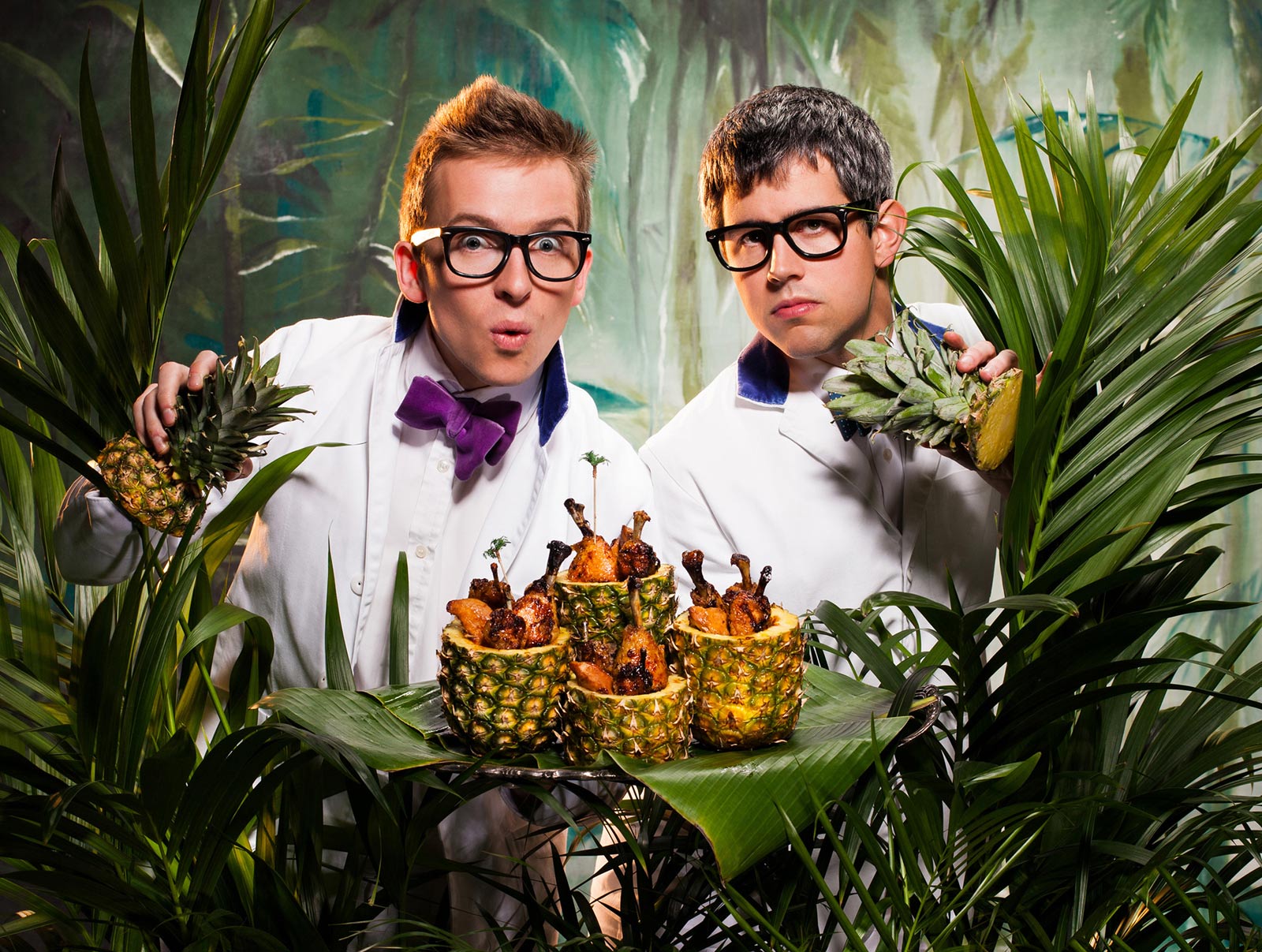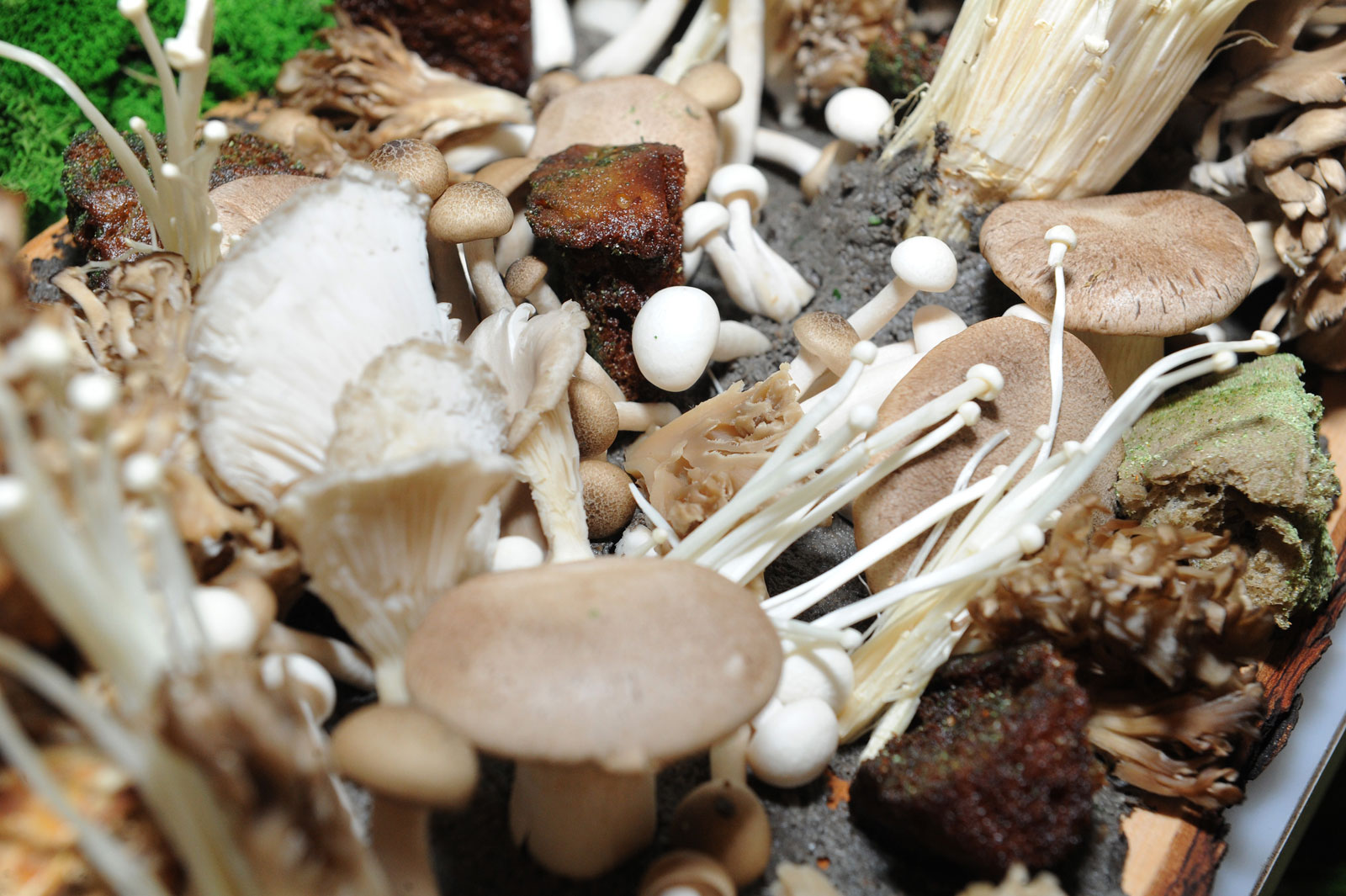Interview: Food Artist Duo Bompas + Parr
Talking explosions, inspiration and more at Stella Artois’ Le Savoir dinner

There are few among us who have turned food and drink into an adventure as well as Bompas + Parr. The British “food artist” duo, in essence, condensed the idea of dinner theater into a spectacle wherein the edibles are the performer. Their inspiration is vast, from Roald Dahl’s “The Twits” to Stella Artois (whose four season-invoking Le Savoir dinner we met them at) and they’ve done everything from blow up beer to create a bar of breathable alcohol and serve a marshmallow cake at the royal wedding.
Explaining some of the wonders they produced for the Stella Artois dinner sheds further light on their uncommon collective imagination. After an hour of socializing over beer, guests were brought into a low-lit greenhouse laboratory-like hybrid. Within one could pluck up caraway glazed carrots and radishes from dirt (actually composed of grain used in Stella) or pull a chili- or strawberry-infused tomato right off of a vine. Another station allowed guests to forage for their own mushrooms from an equally delectable mushroom paté soil. At the seated dinner, perhaps the most mind-bending experience was dipping one’s bread into the wax of a melting candle, which was, in fact, beef tallow. The dessert portion of the evening featured a honey jelly, which is the basis of where their culinary adventures actually began all those years ago, but we’ll let Sam Bompas and Harry Parr explain it themselves.

For a lot people, food is already inspiring and can be an adventure. How do you take it into a different direction?
Sam Bompas: For better or worse, we are lucky to be living in a society where people aren’t just going out to eat to fulfill their basic caloric needs. A lot of time it can get decadent. And this is wonderful. But people also go out for entertainment. So we see food as a realm of the arts which fulfills a role in people’s lives. They could be going to the opera or going to surf with mermaids; you know, whatever people do in their spare time. So for that, I think the food [we create] needs to be spectacular but we must bring the theatrical into it as well, so that it acts like a glove around the food. Also, I like it if you can have a meal where you are the hero of your own adventure.
Harry Parr: If you take something that is very familiar—a lot of the experiences people are seeking with food are not so, they are new, trying something different or being the first in a new restaurant—but if you take something familiar like Stella or like what we did when we started off with jelly, and you just really drive down into it, every food item is very special. There’s way more to it than you can imagine. In the way you consume it, even. And when you go into telling people those stories and allowing them to experience it in new ways it moves forward. It does not need to be a complicated thing to start with. It just needs to be something that people are familiar with but deeper.

Do these experiences begin with a brand or type of food or just some idea that you want to convey?
HP: It’s really both. Every work involves a new product and there will be so many stories within it. They’re not necessarily ones that have been communicated. But when you go back into the history and start searching it, it actually turns into why this food or brand became successful There is a thread of truth and a reason for being. That’s a really important thing: how we communicate that. We then think of how you can combine that with something that is totally unexpected. We combine this all and we create something special in the middle. It reinvigorates things, some that have been around for hundreds of years.

Do you have “Aha!” moments when you know exactly what you need to do?
SB: We certainly have terrifying moments where we realize the scale and complexity and intensity of what we’ve got to create. With this production alone there are 400 staff. We came onsite and there were clans of people rigging all the lights in and doing the final set dressing. All of these people who are at the zenith of their fields giving a performance that one also involves food. That is the satisfying moment.
HP: You can plan and plan and plan but not know what’s going to happen until people are actually in the room. That’s the nice thing about working with food, as well. Food brings people together anyway. Then, if you can do stuff to enhance it, from the moment people have a drink in their hand, hopefully you can make it all even better.

How did the Stella collaboration happen?
SB: We’ve obviously been doing lots of work often taking a single food and using that as a jumping off point for creating an entire experience. We obviously did that with jelly, but then have done it with many many more foods, from flavor-changing chewing gums to chocolate waterfalls and cooking steak with lava. Stella was interested in us getting people to think about the flavors behind it all and within the chalice. If you are using purely food terms, that could become quite abstract. What we wanted to do was move that conversation to a more emotional level and a hard science level. We came to the notion of a multi-sensory immersion performance but using environment, sound, lighting and the dishes themselves to tease out the cardinal flavor notes.
We worked with Professor Charles Spence of the Oxford Food Lab. He starts of with a research piece about what the environment should be and the sound should be like for each experience. And he notes all the different flavors in Stella Artois. That was moved into the seasons. We used the food to weave through the flavors and the emotions there.

How do you know at the end of the night if it was a successful occasion?
HP: A lot of it has been about us creating stories for people to tell… at the pub. To create an experience where someone goes to their friends and says, “You’ll never guess what happened to me,” and tell them something absolutely unbelievable, where you can never imagine it taking place, for us, that’s how we’ve judged the success.
SBFor years I used to do the door for our events and when you are hosting, or at the end of an event like tonight, you want to pay attention to whether or not people smiling when they come out. When you can do that, it’s something to aspire to.
Any insight on what you’re doing with The Twits?
SBThat’s a completely different direction than tonight. This night is all about fancy and celebratory and the four seasons whereas The Twits is just disgusting.
HPWhen you are doing an event where people expect it to be disgusting, it can’t just be disgusting though. You still have to make it worth the money. It has to be a load of other things, as well. People need to feel disgusted but full and still have a great meal. As a line to trek, that’s pretty challenging.
Images courtesy of Getty












